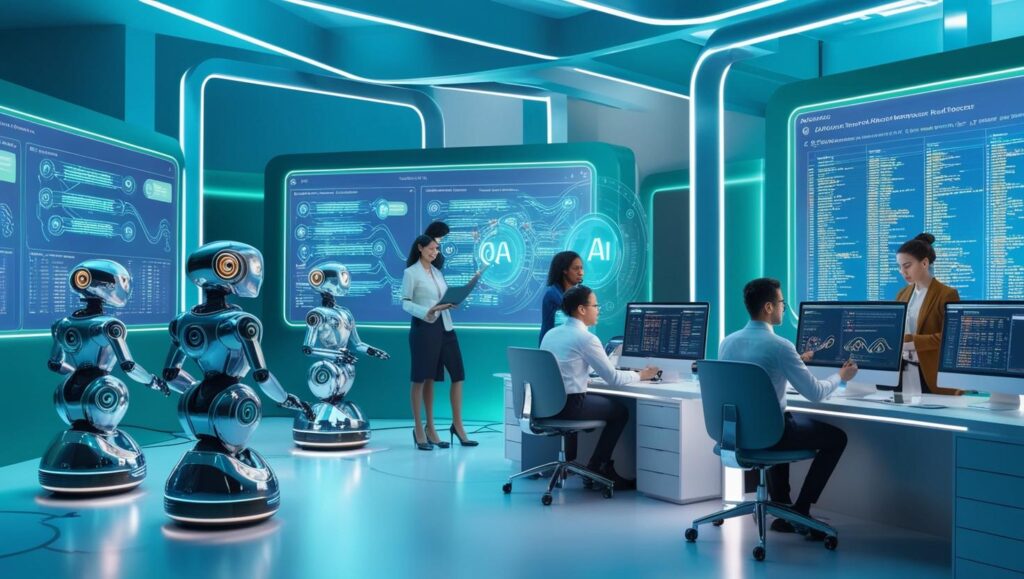
QA is evolving faster than ever, and testers who fail to adapt risk becoming obsolete. As AI-driven testing, automation, and DevOps integration continue to reshape software development, QA professionals need to stay ahead.
Many testers worry:
❌ “Will AI replace manual testers?”
❌ “Do I need to become a full-stack developer to survive in QA?”
❌ “How do I future-proof my QA career?”
The truth? AI and automation aren’t replacing QA—they’re transforming it. Testers who embrace change, learn new methodologies, and adapt to industry trends will have more career opportunities than ever before.
In this post, we’ll break down:
✅ How AI is changing the QA landscape
✅ The rise of automation & no-code/low-code testing
✅ Why shift-left & DevOps are becoming the norm
✅ How QA professionals can future-proof their careers
1. The Rise of AI-Driven Testing: What’s Changing?
AI is no longer a futuristic concept—it’s actively transforming QA. AI-powered tools can: 📌 Self-heal flaky automated tests (e.g., tools like Testim, Mabl) 📌 Generate & execute test cases automatically (AI-assisted test generation) 📌 Detect UI changes & adapt tests dynamically 📌 Enhance visual & regression testing with deep learning models
🚀 What This Means for QA Professionals:
- AI won’t replace manual testers, but it will reduce redundant & repetitive testing.
- Testers must learn how to work with AI tools, leveraging them to speed up testing cycles.
- Exploratory testing, risk analysis, and human-driven test design will still be critical.
Learn more about Test Automation for Beginners: Tools, Frameworks, and Key Practices.
2. Automation is Expanding: Low-Code & No-Code Testing
Many testers assume automation requires deep coding knowledge, but the industry is moving toward:
✅ Codeless test automation tools (like Katalon, TestRigor)
✅ Low-code frameworks (e.g., Cypress, Playwright with built-in helpers)
✅ AI-assisted test automation that writes scripts automatically
Does this mean testers don’t need to code anymore?
❌ No. While low-code tools are increasing accessibility, testers who can understand and modify automation frameworks will have a clear advantage.
🔹 The best approach? Balance manual & automation skills—know how to test with and without code so you can adapt to different projects. If you’re transitioning from manual to automation, check out Mastering the Core QA Skills: From Manual to Automation for a structured learning path.
3. Shift-Left Testing & DevOps: Why QA Must Move Faster
Traditional QA worked like this: 🛑 Developers write code → QA tests it later → Bugs get found too late.
Now, companies are pushing QA earlier into development:
✅ Shift-left testing ensures testers validate code before it’s fully built.
✅ QA is integrated into CI/CD pipelines, enabling continuous testing.
✅ QA works alongside developers & product teams, finding defects earlier.
🚀 What This Means for Testers:
- You need to be involved earlier in development.
- Understanding CI/CD pipelines, automation, and DevOps is now a must-have skill.
- Exploratory testing is becoming more valuable, as automation can’t handle all edge cases.
To stay competitive, testers need to understand DevOps and continuous testing strategies. Google’s Testing on the Toilet provides excellent insights into how top tech companies integrate QA into their CI/CD pipelines. You can also learn how shift-left testing is changing QA’s role in The Value of Being Agile: QA Testing in Agile Environments.
4. How to Future-Proof Your QA Career
With AI and automation advancing, how can testers ensure job security and career growth?
Key Strategies for Staying Ahead:
✅ Master AI & automation testing tools – Learn how AI-driven testing works.
✅ Improve exploratory testing & risk-based analysis – These are skills AI can’t replace.
✅ Gain DevOps & CI/CD experience – Understand how QA fits into deployment pipelines.
✅ Expand technical skills (but don’t overcomplicate it) – Learn API testing, basic scripting, and test automation.
✅ Stay adaptable—embrace continuous learning – QA will keep evolving, and stagnation is the biggest risk.
If you’re looking for the best AI tools that can enhance your QA workflows, check out The Best AI Tools to Use in 2025, What’s Worth Your Time? on EngineeredAI.
Conclusion: The Future of QA is Bright—for Those Who Adapt
❌ Testers who rely solely on manual test cases without adapting will struggle. ✅ Testers who evolve, embrace automation, and learn AI-driven testing will thrive.
The key takeaway? QA isn’t dying—it’s evolving. The best testers won’t just execute test cases—they’ll drive testing strategy, automation, and quality across teams.
🔜 What’s Next? At 1 PM, we’ll explore how QA professionals can balance manual, automation, and AI-driven testing in real-world projects.


1 thought on “QA and the Future – AI, Automation, and Trends You Need to Watch”
Comments are closed.